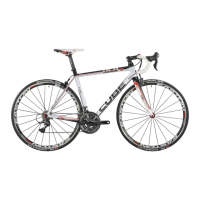MTB/ ROAD BIKE/ TREKKING
4.9 frame material / information
on carbon material
Modern bicycle frames consist of aluminium alloys,
carbon, steel or titanium.
You can nd your frame material under
point 16, in the handover certicate, or
by consulting your specialist retailer.
Gefahr von Personen- und
Sachschäden!
Carbon is a modern material used in bi-
cycle and vehicle construction. However,
carbon components are highly sensitive.
Errors in its assembly or use could lead
to breakages and therefore hazardous
driving conditions, falls, accidents and
material damage.
•
It is imperative that you observe all of the
following information regarding the use of
carbon parts.
•
Should you have any questions relating to
the use of carbon parts, please consult your
specialist retailer.
Risk of Personal Injury and Material
Damage!
Shock and impact loads which may occur
as a result of unintended use (see chap-
ters 2.1.3 and 4.1) or stone-chipping, may
lead to inconspicuous damage in the
carbon bres and/or delamination (= a
dissolution of the bonded carbon layers).
Such damage, combined with the forces
arising from the operation of the bicycle
can suddenly break carbon parts and
therefore lead to dangerous driving
conditions, falls, accidents and material
damage
•
Your bicycle must solely be used for the in-
tended purpose (see chapters 2.1.3 and 4.1)
•
After falls or other large mechanical stresses
which are not prescribed under the normal
biking operations, carbon frames and com-
ponents should no longer be used.
•
Please consult your authorised specialist
retailer immediately after a fall.
4.9.1 Information on frame
construction
These high-end products are produced by hand.
Deviations in nish may therefore occur, however,
this represents no grounds for complaints.
4.9.2 How to use your carbon
parts correctly
1. Do not, under any circumstances, mount
brackets, screws, clamps or other ele-
ments which exert mechanical pressure
on the carbon tube.
2. Clamping onto bike stands or other wall
brackets:
•
Never clamp your bicycle around the carbon
tube or carbon seatpost in the clamping
jaws of a bike stand.
3. Please take care when using shackle
locks! These may, under certain circum-
stances, cause damage to your frame.
•
When using shackle locks, please ensure
that these only touch the respective carbon
tube at the most, and are not exerting
pressure.
4. Saddle clamp / seatpost:
•
The prescribed tightening torque of the
saddle clamp bolt is 5-6 Nm.
•
The seat tube must not be scoured or me-
chanically processed in any other way.
•
Please consult your authorised specialist
retailer immediately after a fall.
•
The seatposts and seat tubes must not be
lubricated. Only a carbon assembly paste
may be used.
•
Aluminium seatposts may only be mounted
using a carbon assembly paste.
•
The seat clamp may not be closed if the seat
post has been removed.
Carbon is a more commonly used term for carbon-
bre reinforced plastic. This describes a bre-plastic
composite material in which the carbon bres are
embedded in several layers in a plastic matrix.

